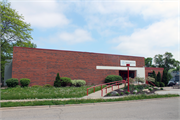Property Record
2001 Taft Street
Architecture and History Inventory
| Historic Name: | South Madison Neighborhood Center |
|---|---|
| Other Name: | Boys and Girls Club of Dane County |
| Contributing: | |
| Reference Number: | 241101 |
| Location (Address): | 2001 Taft Street |
|---|---|
| County: | Dane |
| City: | Madison |
| Township/Village: | |
| Unincorporated Community: | |
| Town: | |
| Range: | |
| Direction: | |
| Section: | |
| Quarter Section: | |
| Quarter/Quarter Section: |
| Year Built: | 1949 |
|---|---|
| Additions: | |
| Survey Date: | 2019 |
| Historic Use: | recreational building/gymnasium |
| Architectural Style: | Contemporary |
| Structural System: | |
| Wall Material: | Brick |
| Architect: | |
| Other Buildings On Site: | |
| Demolished?: | No |
| Demolished Date: |
| National/State Register Listing Name: | Not listed |
|---|---|
| National Register Listing Date: | |
| State Register Listing Date: |
| Additional Information: | City of Madison, Wisconsin Underrepresented Communities Historic Resource Survey Report: The South Madison Neighborhood Center established on the south side of Madison in 1949 by Willie Lou Harris, Kenneth Newville, and George Gerrard with the assistance of the surrounding community and the local carpentry and plumbers’ unions. For more information on Willie Lou Harris, please see the Notable People chapter. The first buildings for the neighborhood center were Air Force barracks that were moved from Truax Field on the east side of Madison down Park and Beld Streets to a lot at 2001 Taft Street in the Bram’s Addition neighborhood. The social welfare organization provided school programs for young children, neighborhood activities, and social programs and meeting space for adults. The South Madison Neighborhood Center soon came under the control of the Madison Neighborhood Centers organization, which also included the Atwood Community Center and the Neighborhood House. In 1973, the organization changed its name to the United Neighborhood Centers of Dane County (UNC) and expanded to include the East Madison Community Center, Wil-Mar Neighborhood Center, Broadway/Simpson/Waunona Neighborhood Center, Deerfield Community Center, Vera Court Neighborhood Center, and the Atwood Community Center. Richard Harris, son of the center’s founder Willie Lou Harris, became the administrator of the neighborhood center in 1980. In 1983, the South Madison Neighborhood Center, under the leadership of Richard Harris, successfully filed a complaint with the Office of Civil Rights claiming racial discrimination by the Madison Metropolitan School District. Plans to close Hoyt, Longfellow, and Sherman elementary schools and Lincoln and Sherman middle schools undermined equal educational opportunities in South Madison. The UNC dissolved in 1997. In 1999, the South Madison Neighborhood Center became a chartered affiliate of the Boys and Girls Clubs of America that served over 600 young people. The community center experienced a series of large additions and alterations throughout its history. In 2001, a major addition for educational purposes by the Boys and Girls Club expanded the facility by 8,000 square feet. |
|---|---|
| Bibliographic References: |
| Wisconsin Architecture and History Inventory, State Historic Preservation Office, Wisconsin Historical Society, Madison, Wisconsin |

